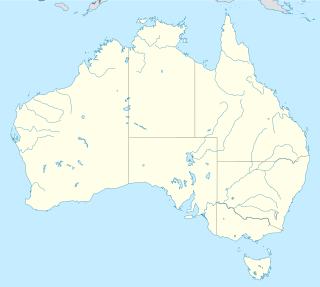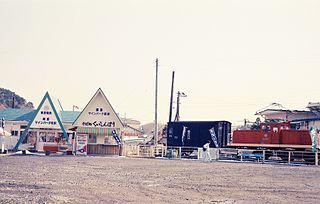Related Research Articles

Red Dog Mine is a census-designated place (CDP) in the Northwest Arctic Borough of the U.S. state of Alaska. The population was 309 at the 2010 census, up from 32 in 2000.

Faro is a town in the central Yukon, Canada, formerly the home of the Faro Mine, the largest open pit lead–zinc mine in the world as well as a significant producer of silver and other natural resource ventures. The mine was built by the Ralph M. Parsons Construction Company of the USA with General Enterprises Ltd. of Whitehorse being the main subcontractor. As of 2011, the population is 344, considerably lower than its peak of over 2,100 in February 1982. Faro was named after the card game. credited with discovering several significant deposits of lead and zinc ore and playing a major role in the discovery of the Faro Mine, which became Canada's largest lead-zinc mine.

Tiger is a former populated place in Pinal County in the U.S. state of Arizona. The town was settled as Schultzcirca 1881 in what was then the Arizona Territory, then later reestablished as Tiger after World War I.

Silver mining in Nevada, a state of the United States, began in 1858 with the discovery of the Comstock Lode, the first major silver-mining district in the United States. Nevada calls itself the "Silver State." Nevada is the nation's second-largest producer of silver, after Alaska. In 2014 Nevada produced 10.93 million troy ounces of silver, of which 6,74 million ounces were as a byproduct of the mining of gold. The largest byproducers were the Hycroft Mine, the Phoenix Mine, the Midas Mine and Round Mountain.
Gold mining in Alaska, a state of the United States, has been a major industry and impetus for exploration and settlement since a few years after the United States acquired the territory in 1867 from the Russian Empire. Russian explorers discovered placer gold in the Kenai River in 1848, but no gold was produced. Gold mining started in 1870 from placers southeast of Juneau, Alaska.

The Castle Dome Mountains are a mountain range in Yuma County, Arizona, within the Kofa National Wildlife Refuge. Castle Dome Peak, the high point of the range, is a prominent butte and distinctive landmark. The peak is 3,776 feet (1,151 m) high, and is located at 33°05′04″N114°08′36″W. Castle Dome was named by American soldiers at old Fort Yuma in the 1880s. Early Spanish explorers called the same peak Cabeza de Gigante, "Giant's Head."

Namtu is a town situated in northern Shan State, Myanmar. It is famous for Bawdwin and Namtu silver mines. NamTu River is flowing across in the middle of town and the transportation from Namtu to Lashio or Namtu to Mandalay is by bus.
The Cavnic mine is a large mine located in the northwest of Romania in Maramureș County, 26 km southwest of Baia Mare and 576 km north of the capital, Bucharest. Cavnic represents one of the largest polymetallic reserves in Romania having significant reserves of gold, silver, copper, lead and zinc amounting to 20 million tonnes of ore grading 1g/t gold, 30g/t silver, 2% lead, 3% zinc and 1% copper. The resources amount to 640,000 oz of gold, 19.2 million oz of silver, 400,000 tonnes of lead metal, 600,000 tonnes of zinc metal and 200,000 tonnes of copper metal.

The Golden Grove Mine is a copper, lead, silver, zinc and gold mine located 52 km south-southeast of Yalgoo, Western Australia.
Wheaton Precious Metals Corp. is a multinational precious metals streaming company. It produces over 26 million ounces and sells over 29 million ounces of silver mined by other companies as a by-product of their main operations.

Zinc mining is the process by which mineral forms of the metal zinc are extracted from the earth through mining. A zinc mine is a mine that produces zinc minerals in ore as its primary product. Common co-products in zinc ores include minerals of lead and silver. Other mines may produce zinc minerals as a by-product of the production of ores containing more valuable minerals or metals, such as gold, silver or copper. Mined ore is processed, usually on site, to produce one or more metal-rich concentrates, then transported to a zinc smelter for production of zinc metal.
The Peñasquito Polymetallic Mine is the fifth largest silver mine in the world and the second largest in Mexico. It is located in north-eastern corner of the State of Zacatecas and is wholly owned by Newmont Goldcorp. It is an open pit operation which began operations in March 2010, but still managed to produce 13,952,600 ounces of silver that year. Estimated reserves for the Peñasquito Mine are 17.82 million oz of gold, 1,070.1 million oz of silver, 3,214 tons of lead and 7,098 million tons of zinc. The mine has its own radio station, XHESP-FM 98.9 "Radio Peñasco".
The Kišnica mine is one of the largest lead and zinc mines in Kosovo. The mine is located in Novo Brdo in Pristina district. The mine has reserves amounting to 10.3 million tonnes of ore grading 3.77% lead, 1% zinc and 47gr/t silver thus resulting 390,000 tonnes of lead, 103,300 tonnes of zinc and 17 million oz of silver.
The Komdok mine is one of the largest lead and zinc mines in North Korea and in the world. The mine is located in Kumgol-dong, Tanchon. The mine has estimated reserves of 266 million tonnes of ore 0.88% lead and 4.21% zinc.
The Kyzyl-Tash Turk mine is one of the largest lead and zinc mines in Russia. The mine is located in the Tyva Republic, and has 12.9 million metric tons of ore grading 1.55% lead and 10% zinc, or 0.2 million metric tons of pure lead and 1.29 million metric tons of pure zinc. The mine also has reserves amounting to 482,000 oz of gold and 21.7 million oz of silver.
The Ulaan mine is one of the largest lead and zinc mines in Mongolia. The mine is located in southern Mongolia. The mine has reserves amounting to 38.8 million tonnes of ore grading 1.09% lead and 1.9% zinc thus resulting 0.42 million tonnes of lead and 0.74 million tonnes of zinc. The mine also has reserves amounting to 256,000 oz.
The Salairskoye mine is one of the largest lead mines in Russia. The mine is located in southern Russia in Novosibirsk Oblast. The mine has reserves amounting to 25 million tonnes of ore grading 0.13% lead, 2.42% zinc and 7 million oz of silver.

The Hosokura mine was one of the largest lead and zinc mines in Japan. The mine was located in the town of Uguisuzawa, Miyagi Prefecture in the Tohoku region of northern Japan, in what is now the city of Kurihara. The mine had production of 26 million tonnes of ore grading 1.59% lead, 4.12% zinc and 12.8 million oz of silver before closing in 1987.

The Kosaka mine was one of the largest copper, lead and zinc mines in Japan. The mine is located in Tōhoku region of northern Japan in the town of Kosaka, Akita Prefecture. The mine had reserves amounting to 30 million tonnes of ore grading 2.84% lead, 8.48% zinc, 1.1 million oz of gold and 177.3 million oz of silver.
The Toyoha mine is one of the largest lead and zinc mines in Japan. The mine is located in northern Japan in Hokkaido. The mine has reserves amounting to 13 million tonnes of ore grading 2.1% lead, 7% zinc and 51.6 million oz of silver.
References
- 1 2 "Mineral deposits of Northern Asia". docstoc.com. 2012. Retrieved 2013-07-10.